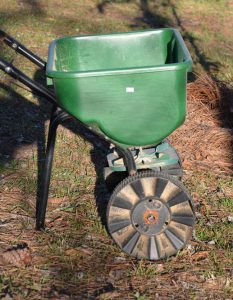Plants require nutrients to grow and they typically get them from the soil. Oftentimes, we apply fertilizer to help them along. Fertilizers provide specific nutrients for your plants and are available in a variety of different forms. When used correctly, fertilizers are a great tool that can help plants thrive. If used incorrectly, fertilizers can harm plants and also the environment.
Different plants have different nutrient requirements and in many cases, fertilizer may not be necessary so do your research before purchasing fertilizers. Sometimes, certain plants, like azaleas or blueberries, need a special formulation of fertilizer.
Think about having your soil tested to see what nutrients are already present in your soil. Contact your local Extension Office for sampling procedures.
Fertilizer Components
Most fertilizers used in the home landscape and garden are blends of several elements mixed together to create a specific formulation of plant nutrients.
Macronutrients
Macronutrients are nutrients required by plants in relatively large amounts for optimum growth. The three main nutrients contained in fertilizers are nitrogen (N), phosphorus (P), and potassium (K). Most folks are familiar with these because they are represented by three numbers that appear on the fertilizer bag. You may be familiar with the term ‘complete fertilizer’. This means the fertilizer with contain all three of the major plant nutrients – N, P and K. Other macronutrients include calcium (Ca), magnesium (Mg), and sulfur (S).
Micronutrients
Micronutrients are nutrients most plants need in small quantities. They are sometimes referred to as trace elements or minor elements. These nutrients include boron (B), chlorine (Cl), copper (Cu), iron (Fe), manganese (Mn), molybdenum (Mo), and zinc (Zn). They are often available in sufficient quantities in the soil, but are also present in many fertilizers. Micronutrients are also sold as individual nutrients.
Types of Fertilizer
Inorganic Fertilizers
Inorganic fertilizers are materials that are mined or synthesized from non-living materials. Many inorganic fertilizers contain nutrients that are immediately available to plants. Others are formulated to be released over a period of time.
Organic Fertilizers
Organic fertilizers are materials that are derived from plants and animals. One of the most common forms of organic fertilizers is manure. Organic matter incorporated into the soil before planting will help fertilize your vegetable plants, but you’ll need to add additional fertilizer after planting.
The quick availability of nutrients, especially nitrogen, is very important in vegetable growing. Therefore, you may want to supplement any organic fertilizer you apply with some inorganic fertilizer for quick feeding. It is a common practice for gardeners to use a combination of fertilizers and techniques in the garden.
Slow- or Controlled-Release Fertilizers
Slow- and Controlled-Release fertilizers provide nutrients to plant roots over an extended period of time. This allows you to fertilize less frequently and prevent nutrients from leaving your landscape and entering groundwater or waterways.
Understanding a Fertilizer Label
The fertilizer label includes a series of numbers that indicate the percentage of nitrogen, phosphorous, and potassium, by weight. The numbers will read something like 15-0-15 or 16-2-8. The first number represents the percentage of nitrogen in the bag, the second refers to phosphorus, and the third number is the amount of potassium. For example, a 50-pound bag of 16-2-8 is 16% nitrogen (8 pounds total); 2% phosphorus (1 pound total); and 8% potassium (4 pounds total). The remaining weight is usually comprised of inert ingredients.
Preventing Pollution
- Follow UF/IFAS Recommendations. Rates, application timings and formulas vary depending on the plant.
- Do not fertilize before a heavy rain. If rain is in the forecast for the next 24 hours, wait to apply fertilizer. Heavy rains can cause fertilizer to leach into groundwater.
- Keep fertilizer off hard surfaces. If fertilizer is spilled on a driveway or sidewalk, sweep it up and dispose of it. Fertilizers can wash into storm drains and nearby bodies of water.
For more information on fertilizers visit:
- Explore Blackberry Production at the 2025 Blackberry Field Day - June 5, 2025
- Barefoot Beware: Lawn Burweed! - April 21, 2025
- The Good Guys: Beneficial Insects in Your Garden - March 13, 2025

